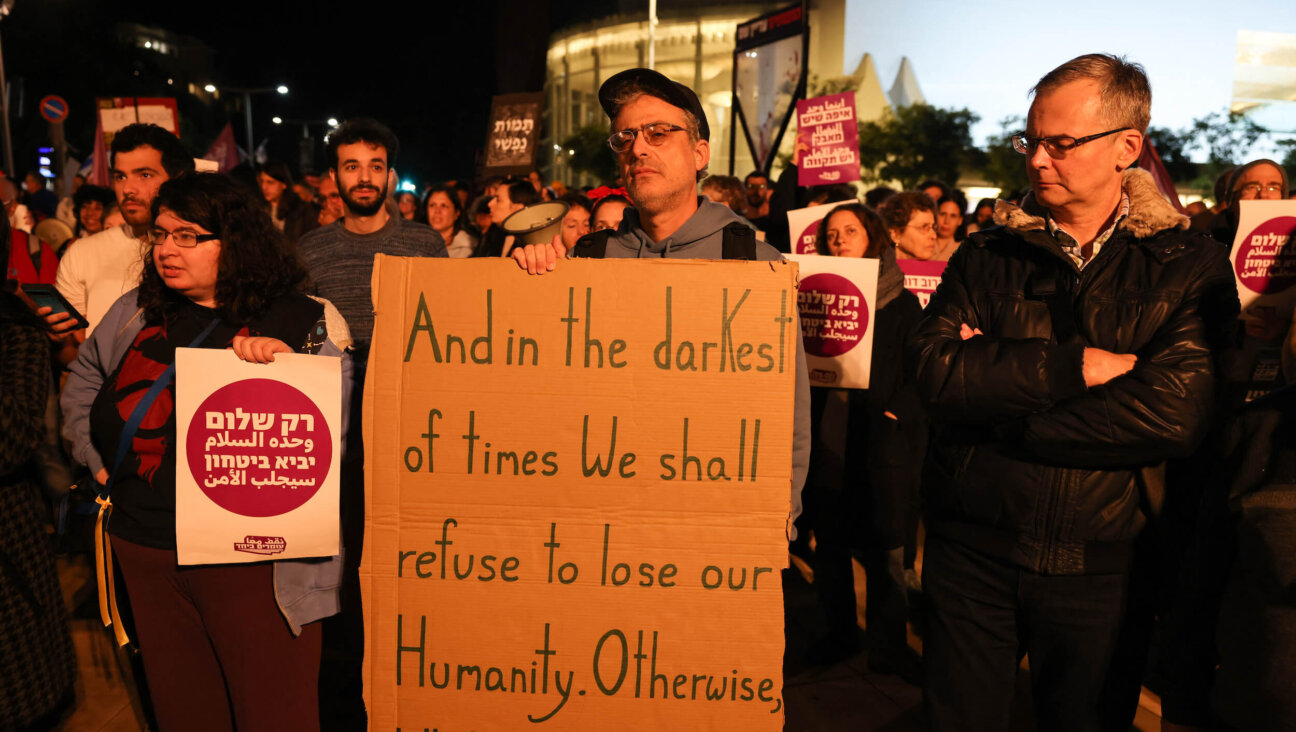Israel is at an existential pivot point. It never needed to go this far.
At every stage, decisions made in Israel cost Israeli and Palestinian lives — and kept Hamas in place

Alma Shahaf, an Israeli soldier, mourns at a memorial for a friend killed at the Nova festival on the 2nd anniversary of the Oct. 7 attacks. Photo by Chris McGrath/Getty Images
Two years after the Oct. 7 massacre, the Middle East is at an absurd pivot point. If Hamas, badly beaten but unbowed, accepts the disarmament element in President Donald Trump’s new peace plan, the region will move toward reconstruction, Gulf-financed normalization, and peace. If it refuses, Israel will likely reoccupy Gaza, miring the region in a ruinous quagmire.
That so much now depends on the whim of a terrorist group is a scandal — the product not only of Hamas’ diabolical strategy and indifference to loss of life, but of American weakness and, crucially, a chain of catastrophically bad choices by Israelis. It did not have to be this way.
The choice between abyss and opportunity is simple in outline and brutal in consequence. One future is endless counterinsurgency in Gaza: Soldiers patrolling hostile alleys and encountering roadside bombs, with Palestinian families under curfew, while Israel’s economy bleeds, its society seethes and its global standing plummets. The other is the disarmament and removal of Hamas, with the hostages returned, Gulf money flowing into reconstruction, and quite possibly dramatic moves toward normalization between Israel and Saudi Arabia, and maybe others.
That binary was manufactured, step by avoidable step, by foolishness, arrogance, and weakness from key players:
-
- The political opening: Netanyahu’s return. The rightward realignment of Israeli politics after repeated elections was caused by splits in the center-left and an utter lack of focus from Israel’s moderate parties that made Prime Minister Benjamin Netanyahu’s comeback possible. The coalition he assembled after the November 2022 election, dependent on fanatics and brimming with ex-cons and incompetents, was a disaster waiting to happen. The wait wasn’t long.
-
- Judicial overhaul and societal schism. Netanyahu’s drive to neuter the judiciary and establish an illiberal majoritarian semi-democracy, similar to that of nearby Turkey, began within days of his resuming power. It tore Israeli society apart in 2023, provoking mass protests and deepening social polarization — a rupture that the security establishment warned would project weakness and invite attack.
-
- Ignoring security warnings and intelligence. Knowing this was their position, Netanyahu refused to meet with the heads of the military, Shin Bet and Mossad in the weeks and months before Oct. 7. For their part, the security chiefs also ignored multiple intelligence indicators of Hamas’ intent for a major attack. The signals were minimized or misread — a classic bureaucratic pattern of cognitive failure. As for Netanyahu, his fabulously misguided position, for many years, was that Hamas ruling Gaza was useful because it weakened the Palestinian Authority in the West Bank — which is threatening to him precisely because it is moderate.
-
- Troop diversion to the West Bank. In the run-up to Oct. 7, forces and attention were redirected to the West Bank to manage flashpoints — a political decision tied to coalition pressures to accommodate radical settlers determined to provoke the Palestinians, which left the Gaza boundary defense much thinner than it should have been.
-
- Tactical failures on Oct. 7. When the assault began, early military warnings were not acted on, local commanders were confused, communications broke down, and reinforcements arrived too late, often not until 10 hours later, in a small country.
-
- Blundering into war. Israel briefly held the moral high ground as the world recognized Hamas’ act of barbarism. Arab capitals were unusually receptive, and the diplomatic leverage was enormous. That was the moment to demand the release of hostages, insist on Hamas surrendering Gaza’s administration to the Palestinian Authority, and make disarmament a multilateral demand enforced by a regional-Western coalition. If Hamas had refused, the world would have been forced into an explicit test — and come to understand, once and for all, that war was the option Hamas wanted.
-
- Ignoring the hostage problem. It was obvious from the start that Israel could not destroy Hamas while the group held hostages in Gaza. The captives were a human shield, ensuring that any attempt at “total victory” would be self-defeating. Netanyahu denied this, promising that annihilation was possible while sending the army in and out of the same ruins. It led to two years of an endless cat-and-mouse game.
These step-by-step misfires, together, make it clear that, at every subsequent juncture, Netanyahu chose to prolong kinetic action. A permanent state of emergency enabled him to argue for deferring accountability and shifting the discussion away from the unwinnable one about his role in Oct. 7.
And the United States showed weakness and complicity with nonsense at key moments.
-
- A missed opportunity. In late 2023 and early 2024, then-Secretary of State Antony Blinken was crisscrossing the region to put together a comprehensive plan: return of all hostages, the Palestinian Authority restored to Gaza, normalization with Saudi Arabia. Officials in President Joe Biden’s administration believed it was achievable. Netanyahu refused, knowing his coalition would collapse. Biden, astonishingly, effectively accepted the rebuff — a display of weakness that allowed the war to grind on, and, of course, hurt the Democrats’ chances to retain the American presidency.
-
- Biden’s big error. Biden went further, publicly endorsing Netanyahu’s own outline for ending the war in exchange for hostages. Within weeks, Netanyahu reneged, and Biden again let it pass. The cost was counted not only in the lives of Palestinian civilians, but also in those of Israeli soldiers and hostages who might have been saved.
-
- And Trump’s. By January 2025, after 15 months of devastation, a reelected Trump forced Netanyahu to accept what was essentially the same plan as Biden had put forward. But Netanyahu walked away halfway through implementation, without even denying that doing so was a violation of the deal — because Trump allowed him to (and indeed was then advocating for the expulsion of all Gazans in favor of a U.S.-built “riviera”).
Each of these errors compounded the others and cost many lives.
On the Palestinian side, it is widely believed that some 65,000 people are dead, over half of them civilians — although all numbers from Gaza are suspect, as they come from authorities linked to Hamas. According to Israel’s Defense Ministry, 1,152 Israeli soldiers and security personnel have been killed in the course of the war, including several hundred in the Oct. 7 attack itself. Of the 251 people abducted on Oct. 7, the vast majority of them civilians, at least 83 are believed to have been killed — the cost of these decisions to not prioritize their release.
At every pause when Netanyahu prolonged the war, he could say “Hamas is not yet destroyed.” People who both wanted Hamas gone and the hostages freed could be manipulated into tolerating continuation of fighting. That line sustained support from about a third of the public.
What are the lessons of this litany of errors — other than the obvious one, that Netanyahu must be removed from power at almost any cost?
The big one is that Israel, even if Hamas says no to Trump’s deal, must resist the impulse to push forward militarily. Two years of devastation have made it plain: The war cannot be “won” so long as hostages remain in Hamas’ grip, and every repetition of the cat-and-mouse game in Gaza only weakens Israel’s legitimacy and social cohesion, while strengthening Hamas’ narrative.
If Hamas refuses to disarm, the wiser course is to flip the script, and increase pressure on them without further military action.
The priority must be the hostages: Every diplomatic channel and instrument of international pressure should be deployed to secure their release. Humanitarian suffering must be addressed by offering civilians temporary refuge — in Egypt, in the West Bank, or elsewhere — guaranteed by international commitments of return once Hamas is gone.
This is not ethnic cleansing; it is protection, analogous to Ukrainians sheltering in Poland during the Russian assault. Properly framed, it exposes Hamas as the jailer of Gaza’s people.
If Hamas breaks, then excellent: The Trump plan can proceed with a technocratic Palestinian government in Gaza, reforms in the Palestinian Authority, Gulf-financed reconstruction, and normalization with Saudi Arabia and beyond. If Hamas refuses, the world must be made to see that Palestinian misery is not the people’s inevitable fate, but the direct consequence of Hamas’ obstinacy.
The fact that the Middle East’s future now waits on Hamas is not some cosmic inevitability; it is the fruit of a sequence of political, tactical and strategic mistakes. Israel must learn from this disaster, and take steps never to be so exposed in the future.
















